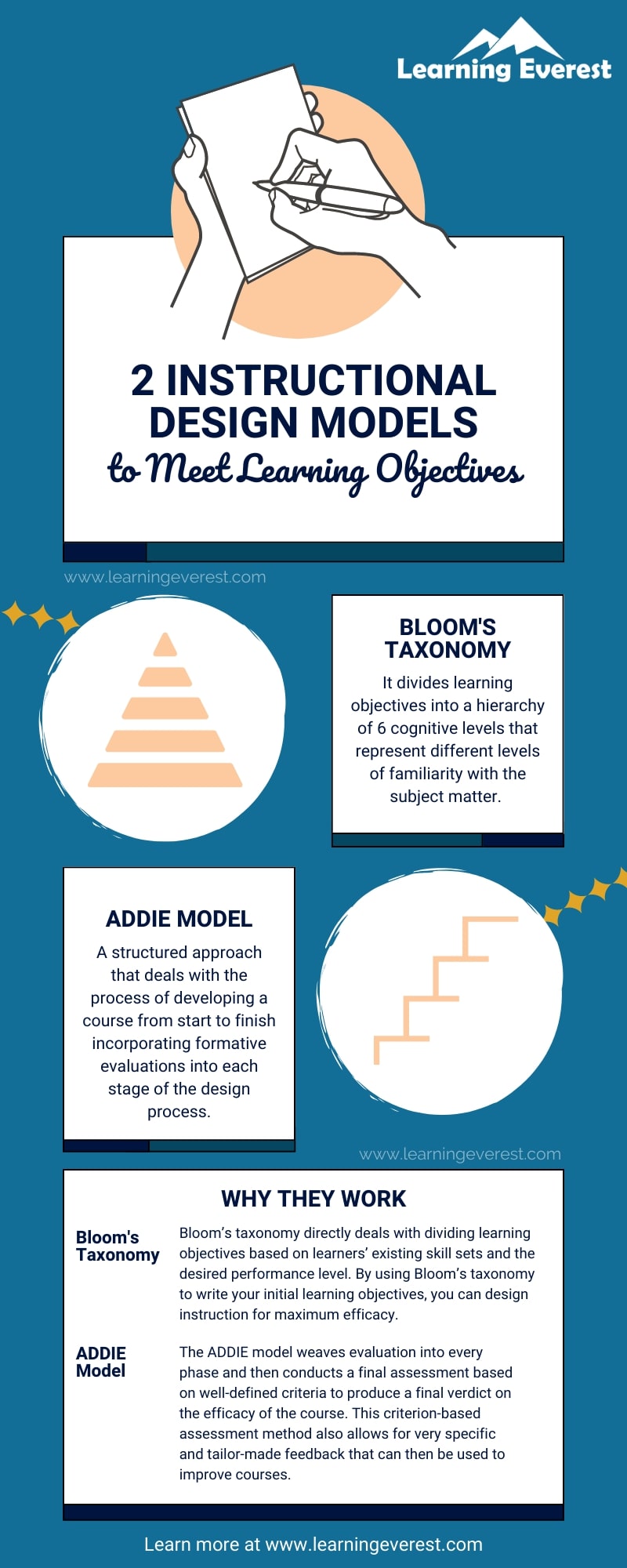In this article, we will explore 2 famous instructional design models that are highly effective and compatible with e-learning so you can build corporate training programs that produce concrete results.
Learning objectives are the bread and butter of training programs. They provide the instructional design process with direction, delineate what successful learning looks like, and ensure that learning resources are put to good use. The best way to develop courses that meet learning objectives is to follow instructional design models to structure your content creation process. There are many instructional design models; however, a few have stood the test of time and seamlessly fit into e-learning instructional design processes.
Here are two famous Instructional Design Models to Meet Learning Objectives
Famous Instructional Design Model No. 1: Bloom’s Taxonomy
Bloom’s taxonomy is a framework for writing learning objectives that has been around since the 1950s.
It divides learning objectives into a hierarchy of 6 cognitive levels that represent different levels of familiarity with the subject matter. The taxonomy is hierarchical because mastery at previous levels is necessary to meet goals at levels. Bloom’s taxonomy is represented as a pyramid for this reason. This classification system is known as a taxonomy because each level has a unique set of action words typically used to write learning objectives.
Moving from the simplest to the most complex, the 6 levels of learning are:
- Remember – remembering entails getting to know the subject matter at a theoretical level and being able to recall or recognize the information. The learner gets to know factual knowledge about the subject.
- Understand – at this level. Learners develop a conceptual understanding of the subject matter instead of a purely factual understanding. They begin to understand the inner workings of the content and develop their interpretations of the information.
- Apply – as the name suggests, this level deals with the practical application of concepts and skills.
- Analyze – analysis requires more complex interaction with the information. At this level of Bloom’s taxonomy, learners are expected to be able to dissect and explore connections in their knowledge base and apply them to new situations effectively.
- Evaluate – evaluation entails independent use of information to make decisions and judgments based on predefined criteria in the area of knowledge they are dealing with.
- Create – creation requires learners to use their knowledge to create an original work based on the knowledge they have gained. This is the most complex learning objective a course can have.
You can find a more comprehensive look into Bloom’s taxonomy and its levels here.
Bloom’s taxonomy directly deals with dividing learning objectives based on learners’ existing skill sets and the desired performance level. Thus, it is a robust instructional design model to ensure that training programs produce the best outcomes. By using Bloom’s taxonomy to write your initial learning objectives, you can design instruction for maximum efficacy.
Famous Instructional Design Model No. 2: ADDIE Model
The ADDIE model is no stranger to seasoned L&D professionals. It is a structured approach that deals with the process of developing a course from start to finish incorporating formative evaluations into each stage of the design process.
ADDIE is an acronym for all the stages in the model:
“A” stands for analyze. Here, instructional designers determine factors like the target audience, available time, type of content, learning constraints, etc. In other words, they figure out all the preliminary information that determine how the instructional design process will play out.
“D” stands for design. Here, the course’s main structure is designed. Learning objectives, content, the flow of the course, course type, instructional strategies, etc., are determined in this phase.
The second “D” in ADDIE stands for development. Here, the strategies chalked down in the design phase are finally put into use. Here, storyboarding and development happen, and IDs pilot test the final deliverable and make any possible changes before the course goes live.
“I” stands for implementation. At this stage, the course is delivered to learners.
“E” in ADDIE represents evaluation. While evaluation takes place in every stage in the form of formative assessments to make prompt assessments, the process does not just end there. Once the course is delivered, a summative assessment is conducted to test whether the course is meeting the desired objectives properly. The summative assessment also creates a feedback mechanism that is then used to improve current and future courses for greater effectiveness.
The ADDIE model is another great instructional design model to ensure learning objectives are being met as it weaves evaluation into every phase and then conducts a final assessment based on well-defined criteria to produce a final verdict on the course’s efficacy. This criterion-based assessment method also allows for very specific and tailor-made feedback that can then be used to improve courses to produce the desired learning outcomes in learners.
Infographic

2 Famous Instructional Design Models to Meet Learning Objectives





